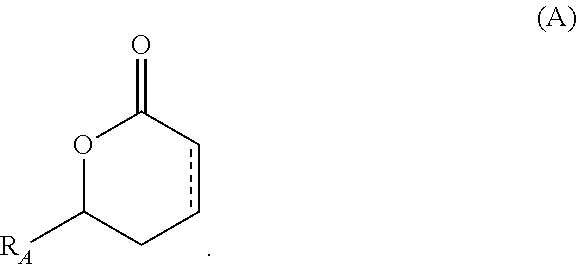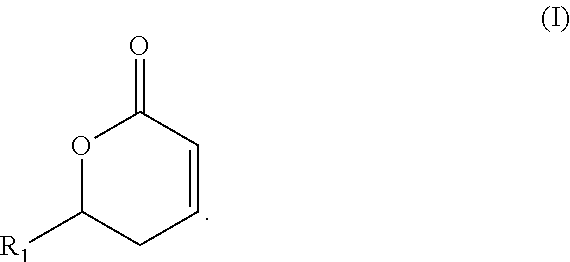Substituted delta-lactones and methods of preparing same
a technology of deltalactones and substituted deltalactones, applied in the field of substituted deltalactones, can solve the problems of labor-intensive multi-step synthesizing, and achieve the effects of low cost, mild reaction, and improved yield of delta-lactones
- Summary
- Abstract
- Description
- Claims
- Application Information
AI Technical Summary
Benefits of technology
Problems solved by technology
Method used
Image
Examples
example 1
Synthesis of 3-(R)-Hydroxynonanal
[0089]A mixture of castor oil (400 g), water (400 g), and acetic acid (400 g) were cooled to 20° C. in a jacketed reactor while stirring. A ˜6-7% by weight stream of O3 in O2 was diffused into the mixture at a flow rate of 10 L / min for 100 minutes, while maintaining a reaction temperature not exceeding 32° C. The reaction vessel was then purged with N2 and the reaction mixture was transferred into a high-pressure reactor and charged with Palladium black (0.15% by weight). The reaction mixture was stirred under hydrogen atmosphere (350 psi) at 75° C. for 150 minutes until all peroxide had been consumed according to a titrated starch-iodine test. The reaction mixture was then cooled down and filtered to remove the catalyst and the filtrate was placed in a separatory funnel. The organic phase was separated and distilled using a 2″ wiped film, short-path distillation unit at 5 mbar pressure, 60° C. jacket temperature, and 0° C. condenser temperature. A s...
example 2
Synthesis of (R)-6-hexyl-5,6-dihydro-2H-pyran-2-one
[0090]A suspension of zinc (4.58 g, 70 mmol) in THF (300 ml) was stirred at reflux, while adding dropwise a mixture of 3-(R)-hydroxynonanal (5.54 g, 35 mmol) and ethyl bromoacetate (11.7 g, 70 mmol) dissolved in THF (200 ml) to the stirring reaction mixture over 5 hours. The reaction mixture was then cooled down in an ice bath and ˜100 ml 1N(aq.) HCl was added to acidify the reaction mixture to a pH of 2 (gas formed initially during the slow addition). The resulting reaction mixture was refluxed overnight. The next day the organic solvent was evaporated and the remaining aqueous solution was extracted with ethyl acetate. The organic phase was concentrated to yield a crude material, which was dissolved in toluene (100 ml) and refluxed for an additional 3 hours. Removal of the solvent afforded a crude material (6.5 g), which was purified using silica gel chromatography (0 to 20% gradient of ethyl acetate in heptane) to afford (R)-6-he...
example 3
Synthesis of Methyl 5-Oxopentanoate
[0091]A mixture of methyl ester of meadowfoam seed oil (300 g), water (300 g) and acetic acid (300 g) was stirred at 20° C. in a jacketed reactor. A ˜6-7% by weight stream of O3 in O2 was passed through the solution at 10 L / min for ˜90 minutes, while maintaining a reaction temperature not exceeding 32° C. The reaction vessel was then purged with N2 and the reaction mixture was transferred into a high-pressure reactor and charged with Palladium black (0.15% by weight). The reaction mixture was stirred under hydrogen atmosphere (350 psi) at 75° C. for 150 minutes until all peroxide had been consumed according to a titrated starch-iodine test. The reaction mixture was then cooled down and filtered to remove the catalyst and the filtrate was placed in a separatory funnel. The layers separated and the organic layer was removed. The remaining aqueous layer, which contained acetic acid, was then treated with brine. A new, clear organic layer formed which ...
PUM
 Login to View More
Login to View More Abstract
Description
Claims
Application Information
 Login to View More
Login to View More - R&D
- Intellectual Property
- Life Sciences
- Materials
- Tech Scout
- Unparalleled Data Quality
- Higher Quality Content
- 60% Fewer Hallucinations
Browse by: Latest US Patents, China's latest patents, Technical Efficacy Thesaurus, Application Domain, Technology Topic, Popular Technical Reports.
© 2025 PatSnap. All rights reserved.Legal|Privacy policy|Modern Slavery Act Transparency Statement|Sitemap|About US| Contact US: help@patsnap.com



